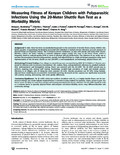| dc.description.abstract | To date, there has been no standardized approach to the assessment of aerobic fitness among children who harbor parasites. In quantifying the disability associated with individual or multiple chronic infections, accurate measures of
physical fitness are important metrics. This is because exercise intolerance, as seen with anemia and many other chronic
disorders, reflects the body’s inability to maintain adequate oxygen supply (VO2 max) to the motor tissues, which is
frequently linked to reduced quality-of-life in terms of physical and job performance. The objective of our study was to
examine the associations between polyparasitism, anemia, and reduced fitness in a high risk Kenyan population using novel
implementation of the 20-meter shuttle run test (20mSRT), a well-standardized, low-technology physical fitness test.
Four villages in coastal Kenya were surveyed during 2009–2010. Children 5–18 years were tested for infection with Schistosoma haematobium (Sh), malaria, filaria, and geohelminth infections by standard methods. After anthropometric and hemoglobin testing, fitness was assessed with the 20 mSRT. The 20 mSRT proved easy to perform, requiring only minimal staff training. Parasitology revealed high prevalence of single and multiple parasitic infections in all villages, with Sh being the most common (25–62%). Anemia prevalence was 45–58%. Using multiplyadjusted linear modeling that accounted for household clustering, decreased aerobic capacity was significantly associated with anemia, stunting, and wasting, with some gender differences.
Conclusions/Significance: The 20 mSRT, which has excellent correlation with VO2, is a highly feasible fitness test for lowresource settings. Our results indicate impaired fitness is common in areas endemic for parasites, where, at least in part, low fitness scores are likely to result from anemia and stunting associated with chronic infection. The 20 mSRT should be used as a common metric to quantify physical fitness and compare sub-clinical disability across many different disorders and
community settings. | en_US |

